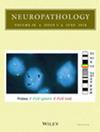低氧诱导因子-1α和血管内皮生长因子在转移性脑肿瘤放射坏死组织和肿瘤组织中的表达和分布对比:病例报告
IF 1.3
4区 医学
Q4 CLINICAL NEUROLOGY
引用次数: 0
摘要
我们报告了一例 70 岁女性转移性脑肿瘤患者的病例,她接受了肿瘤手术切除和放射性坏死治疗。患者有结肠癌病史,曾接受过左枕部肿瘤的手术切除。组织病理学评估显示为转移性脑肿瘤。手术切除后六个月,肿瘤复发,随后进行了全脑放疗,患者接受了立体定向放射外科手术。六个月后,病灶周围水肿加重,患者出现症状。诊断结果为放射性坏死,皮质类固醇起初有效。然而,辐射坏死变得无法控制,患者在立体定向放射手术两年后接受了坏死组织切除手术。病理结果主要显示坏死组织和一些肿瘤细胞。由于坏死组织周围表达了血管内皮生长因子(VEGF)和缺氧诱导因子-1α(HIF-1α),水肿的主要原因被确定为辐射坏死。在未经治疗和复发的肿瘤组织与辐射坏死之间,HIF-1α和VEGF的表达水平和分布存在差异。这种差异表明,肿瘤本身和辐射坏死可能存在不同的水肿形成机制。尽管利用磁共振成像区分辐射坏死和复发性肿瘤仍具有挑战性,但病灶周围水肿的病理生理机制可能是区分辐射坏死和复发性肿瘤的关键。本文章由计算机程序翻译,如有差异,请以英文原文为准。
Expression and distribution of hypoxia-inducible factor-1α and vascular endothelial growth factor in comparison between radiation necrosis and tumor tissue in metastatic brain tumor: A case report
We report the case of a 70-year-old woman with metastatic brain tumors who underwent surgical removal of the tumor and radiation necrosis. The patient had a history of colon cancer and had undergone surgical removal of a left occipital tumor. Histopathological evaluation revealed a metastatic brain tumor. The tumor recurred six months after surgical removal, followed by whole-brain radiotherapy, and the patient underwent stereotactic radiosurgery. Six months later, the perifocal edema had increased, and the patient became symptomatic. The diagnosis was radiation necrosis and corticosteroids were initially effective. However, radiation necrosis became uncontrollable, and the patient underwent removal of necrotic tissue two years after stereotactic radiosurgery. Pathological findings predominantly showed necrotic tissue with some tumor cells. Since the vascular endothelial growth factor (VEGF) and hypoxia-inducible factor-1α (HIF-1α) were expressed around the necrotic tissue, the main cause of the edema was determined as radiation necrosis. Differences in the expression levels and distribution of HIF-1α and VEGF were observed between treatment-naïve and recurrent tumor tissue and radiation necrosis. This difference suggests the possibility of different mechanisms for edema formation due to the tumor itself and radiation necrosis. Although distinguishing radiation necrosis from recurrent tumors using MRI remains challenging, the pathophysiological mechanism of perifocal edema might be crucial for differentiating radiation necrosis from recurrent tumors.
求助全文
通过发布文献求助,成功后即可免费获取论文全文。
去求助
来源期刊

Neuropathology
医学-病理学
CiteScore
4.10
自引率
4.30%
发文量
105
审稿时长
6-12 weeks
期刊介绍:
Neuropathology is an international journal sponsored by the Japanese Society of Neuropathology and publishes peer-reviewed original papers dealing with all aspects of human and experimental neuropathology and related fields of research. The Journal aims to promote the international exchange of results and encourages authors from all countries to submit papers in the following categories: Original Articles, Case Reports, Short Communications, Occasional Reviews, Editorials and Letters to the Editor. All articles are peer-reviewed by at least two researchers expert in the field of the submitted paper.
 求助内容:
求助内容: 应助结果提醒方式:
应助结果提醒方式:


